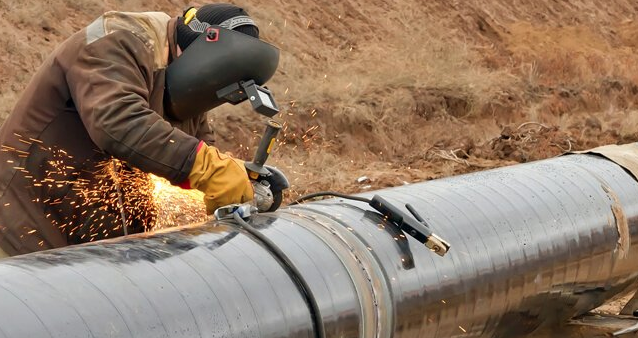When making the perfect weld on a section of pipe there are many variables that go into it. Whether it’s about welding high-pressure pipe, high purity pipe for food and beverage industries or pipe for the oil and gas industries, there are a number of mistakes that lead to problems when pipe welding. Read on to see just some of the mistakes welders can make when welding pipes and some pipe welding techniques needed to avoid these mistakes when on welding jobs.
1.) Forgetting to grind the joints
After oxyfuel and plasma cutting, both of these processes add a layer of oxide to the cut edge of a pipe. It is imperative that this layer is removed prior to welding, as the oxide often has a higher melting point than the base metal. Once the arc weld gets hot enough to melt the oxide layer, it’s too hot for the base metal and can lead to burn-through. On top of this, the oxides can also remain in the weld and cause porosity, inclusions, lack of fusion and other defects. Welders must remember to grind the joint down to the parent material prior to welding, and grind both the inside and outside diameters of the pipe to remove the oxide layer and other potential contaminating elements.
2.) Cutting corners with cutting
When welders work with materials more prone to distortion and the effects of higher heat input (such as stainless-steel or aluminium), a poor cut can lead to poor fit-up and therefore create unnecessary gaps. To make up for this, welders then put more filler metal (thus, heat) into the joint to fill it. This additional heat can lead to distortion in the pipe, and with corrosion-resistant pipe like stainless steel, can reduce the corrosion-resistant qualities of the base metal. This also possibly leads to either a lack of penetration or excessive penetration. Lack of preparation leads to increased weld cycle times, higher consumable costs and potential repairs later on.
If you are using chop saws or band saws to cut pipes used in critical process piping applications should consider buying dedicated orbital pipe cutting equipment in order to guarantee cuts within mere thousands of an inch of the specified parameters. This precision helps ensure optimum fit-up and keeps the amount of filler and heat put into the joint at a minimum.
- Forgetting to cut out and feather tacks
Tacking is paramount to fit-up, and it is recommended that the welder cut out and feather that tack, ensuring the consistency of the final weld. Particularly in shops where a fitter prepares the pipe and then another person welds it, it’s important that the welder knows just what is in the weld. Tacks left in the joint become consumed by the weld, and, if there is a defect in the tack, or if the fitter used the wrong filler metal to tack the joint, there is a risk for defects in the weld. Cutting out and feathering the tacks helps eliminate this potential problem.
- Preparing a joint for MIG processes is different than with Stick welding
Training welders is a top priority for many fab shops, and many welders bring their past job experiences with them. These experiences can be addressed with adequate training, but one common mistake is welders with Stick experience do not understand how to properly prepare a joint for wire processes common in pipe fabrication applications. Welders trained traditionally in Stick and TIG welding often prepare the joint with a heavy landing area and want to keep the gap as narrow as possible. As pipe shops switch over to easier, more productive MIG processes such as Regulated Metal Deposition (RMD™), we prefer welders take that landing area down to a knife’s edge and space the joint at approximately 1/8-inch. This area is wider than those trained in Stick and TIG processes are used to and can lead to a number of problems: focusing too much heat into the edges of the weld, a lack of penetration and insufficient reinforcement on the inside of the pipe. Shops should train their welders to the specifics of each application and make sure they understand different weld preparation and operational techniques before they go to work.
- More shielding gas is not always better
Some welders have a misconception that “more shielding gas is better” and will crank the gas wide open, mistakenly believing they are providing more protection to the weld. This technique causes a number of problems: wasted shielding gas (resources and cost), increased and unnecessary agitation of the weld puddle, and a convection effect that sucks oxygen into the weld and can lead to porosity. Each station should be outfitted with a flow meter and each welder should understand how to set and adhere to the recommended flow rates.
- Buy mixed gas
Typically, for a stainless-steel pipe application that requires 75/25 percent argon/helium, set up a separate tank of argon and a separate tank of helium and then rely on flow regulators to bleed in the proper amount of shielding gas. However, you don’t know what you’re getting in a mix using this method. Buying cylinders of mixed gas from reliable sources, or buying a proper mixer, ensures you know exactly what you’re shielding your weld with and that you’re adhering to proper weld procedures/qualifications.
- Welding power sources don’t cause porosity
Welding power sources don’t cause porosity. Welders should recount their steps back from the point where the porosity has begun. Welders will often find that it starts just when a gas cylinder was changed (loose connections, incorrect gas used), a new wire spool was put in, when someone didn’t prepare the material properly (oxides present in the weld), or if the material was contaminated somewhere else along the line. The problem is often caused by an interruption or problem with the gas flow. Tracing back your steps will often lead to the variable that caused the porosity.
At PCES we are renowned worldwide suppliers of pipe handling, preparation, alignment, cutting and beveling machines. We also stock a wide range of welder protection, welding supplies and general tools. We supply international companies in the construction, petrochemical and pipeline industries.
As well as pipeline welding supplies we stock a range of pipeline construction equipment including welding power tools. PCES Limited offer the solutions to make jobs more accurate and more efficient.
For more information on our services and pipeline welding supplies, please contact us at 01902 713402, email us at sales@pces.co.uk or visit our website.
In the second part of this blog you can see more common mistakes made when welding pipes.

